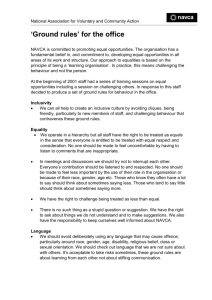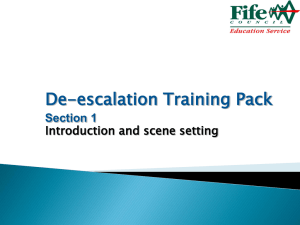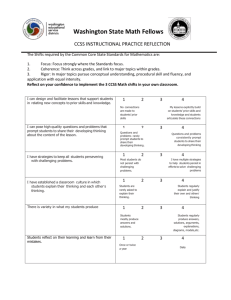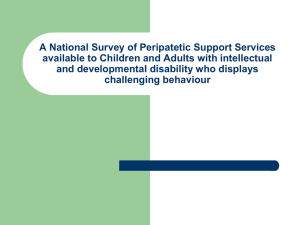Welcome Slide:
advertisement
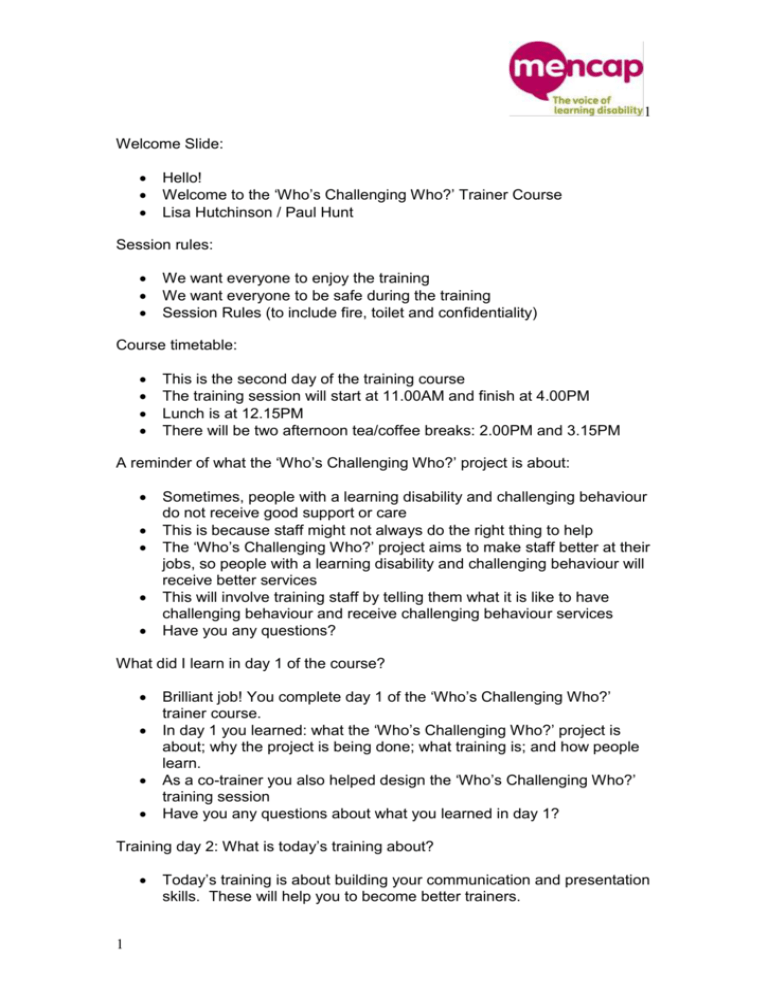
1 Welcome Slide: Hello! Welcome to the ‘Who’s Challenging Who?’ Trainer Course Lisa Hutchinson / Paul Hunt Session rules: We want everyone to enjoy the training We want everyone to be safe during the training Session Rules (to include fire, toilet and confidentiality) Course timetable: This is the second day of the training course The training session will start at 11.00AM and finish at 4.00PM Lunch is at 12.15PM There will be two afternoon tea/coffee breaks: 2.00PM and 3.15PM A reminder of what the ‘Who’s Challenging Who?’ project is about: Sometimes, people with a learning disability and challenging behaviour do not receive good support or care This is because staff might not always do the right thing to help The ‘Who’s Challenging Who?’ project aims to make staff better at their jobs, so people with a learning disability and challenging behaviour will receive better services This will involve training staff by telling them what it is like to have challenging behaviour and receive challenging behaviour services Have you any questions? What did I learn in day 1 of the course? Brilliant job! You complete day 1 of the ‘Who’s Challenging Who?’ trainer course. In day 1 you learned: what the ‘Who’s Challenging Who?’ project is about; why the project is being done; what training is; and how people learn. As a co-trainer you also helped design the ‘Who’s Challenging Who?’ training session Have you any questions about what you learned in day 1? Training day 2: What is today’s training about? 1 Today’s training is about building your communication and presentation skills. These will help you to become better trainers. 2 Training manual: People with a learning disability and challenging behaviour perspective and views of their challenging behaviour and the services they receive. Lunch Warm-up activity We would like you to write or draw about a time when you had to speak in front of people. What was it about, and how did you feel? Want went well? What didn’t go so well? Sara Pickard Sara is going to help us with our presentation skills today. Sara has delivered training for over 5 years. She is going to show us some exercises we can do before a training session to help us stay calm and focused. She will also show us how to use our voice. And our ears And how we use our body and what they tells other people Nerves This exercise is to help calm us if we are nervous. Put your hands on the table. Press your thumb with your finger and count (quietly) to 3. Repeat this with your other fingers. How does everyone feel? Confidence: “I am and I can” This exercise will help us be positive. We will take it in turns to leave the room. That person will come back into the room and pretend that it is a training session. When they come back in Sara will ask them “are you ready?” The person will then say “ I am and I can” The person will repeat it getting louder and louder. This might help you feel more confident. Activity How does everyone feel? Next time you feel nervous repeat this exercise (but only in your head!) Listening Why is listening important? 2 3 Why are good listening skills important? It shows that you are interested in their opinion You can have a conversation with them You can learn things Sara is now going to do a quick listening exercise Sara will tap or clap a beat and you will need to copy her. Well done! Body Language Can you show us some examples of bad body language? Can you show us some examples of good body language? Why is body language important? It shows we are interested It can show people that we are confident It is polite Our Voice Our voice is an important tool We are going to work a little on projecting our voice Someone will have to come up the front. Repeat their name and where they live Sara will slowly move further away You will need to speak louder to make sure Sara can still hear you clearly. How do you feel? How to start a training session The beginning of a training session is important It will give the people you are training a first impression It’s important to start as we mean to go on Training session rules Why are rules important? They can help set the mood of the training Too many rules will make people nervous But some are good to make sure no-one shares secrets To make sure the training isn’t interrupted These are the rules we have for today’s training Should we use these when you are training? Training aims: We use session aim(s) so that people know why they have come to the training session A session aim helps people to think about what they are going to learn 3 4 These are the training aims that you will use in the “Who’s Challenging Who?” training session “We hope the “Who’s Challenging Who?” training session will help people think more positively about people with challenging behaviour”; “The training is based on what we feel and think”; “We want to tell you what it is like to have challenging behaviour, and about the problems we face in our everyday lives”; “We also want to give you advice on how you can provide us with better services” What do you think about these training aims? Learning objectives: Learning objectives are the skills and knowledge people will learn during a training session This what we want staff to have learned by the end of the “Who’s Challenging Who?” training session: What people with challenging behaviour think about how other people perceive them; What problems there are around communication, and what we can do to make communication easier; What problems exist were the person with challenging behaviour lives, and what we can be done to improve these problems; How people feel when they are physically restrained, and what we can do to avoid using restraint; How medication can be unhelpful for some people with challenging behaviour, and how we can support them to deal with medication problems; A person with challenging behaviour wants and needs to be valued equally, listened to and included just like everyone else; and The qualities people with challenging behaviour value in support staff What do you think about these learning objectives? Practice & Feedback: We would like you to have a try at starting a training session Welcome people Go over the session rules List the aims and learning objectives What did everyone think? Well done! Break Training Problems Sometimes the people you are training can cause problems Can you guess what these problems are? 4 5 Well done! A person could talk too much A person could be shy and not take part. Why might this be happening? People could be talking when you are trying to train. Why might this be happening? One way of solving this is by having the rules we talked about earlier Role-play How can we deal with someone who talks too much and dominates the training? How can we encourage a quiet person to take part How can we make sure people aren’t talking amongst themselves during training? Confidentiality Giving our own experiences is a good way of training people But we have to make sure we do it in the right way If we are talking about someone who isn’t in the room, and we aren’t being nice about them is it ok to use their name? No! Why? It is also a good idea not to name any companies or organisations that have treated us badly because they aren’t there to defend themselves. It is also important that whatever stories are shared in the room aren’t told outside the room. Do you think we should have a rule about confidentiality in our training session? How to end a session Before the people we have trained can go home we must do a few things first Can anyone think what they are? First we would quickly list what we have learned. These are called learning objectives We would then ask the people if they have any questions they would like to ask us We would thank everyone for coming And finally ask people to tell us what they think about the training. This is called an evaluation Practice We can now have a practice of ending a session Well done! Break 5 6 What we have learned today Use a relaxation exercise to deal with nerves Feel more confident delivering training Listen to people well Use good body language Use your voice well Start a training session Know what training problems are and how to deal with them Understand why we don’t talk about things we shouldn’t End a training session End of session quiz 1. The Who’s Challenging Who? Project is about A: Cooking B: Challenging Behaviour C: Mental Health 2. Training is a way to help people A: Pick something to eat B: Change the way they think, feel and behave C: Point their houses 3. Listening to what people have to say is important because A: It shows you are interested in their opinion B: You can pretend you’re interested C: It’s not important 4. Good body language shows people that A: You didn’t have enough sleep last night B: You’re not interested C: You are interested 5. Too many rules will A: Relax people B: Make people nervous C: Make everyone really happy 6. Why do we tell people what they are going to learn? A: So they know what to expect B: So if they don’t like it they can go home C: If they fall asleep they can pretend they did all the training 7. A person might not take part in training: A: Because they don’t speak English B: They know all the answers 6 7 C: They don’t understand the activities 8. How can we stop someone from talking too much? A: Stuff something in their mouth B: Tell them to shut their trap C: Encourage someone else to take part 9. Being confidential is good because A: It protects people B: It lets you learn secrets C: It’s a funny TV show 10. At the end of a session you: A: Give everyone a prize B: Give them an evaluation form C: Do a dance. 7

